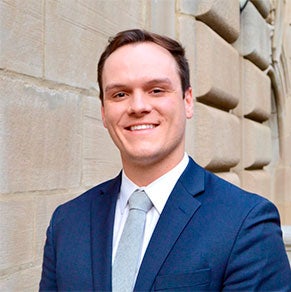 1. Please tell me your name, year in school and any specialties that you’re studying.
1. Please tell me your name, year in school and any specialties that you’re studying.
Hello, my name is Reid Frye, and I am a fourth-year student pursuing a VA hospital-based general practice residency next year. I enjoy nearly all aspects of our profession, but I have special interests in digital workflows, dentoalveolar surgery and implant prosthodontics. I plan to pursue a career in both clinical and academic dentistry.
2. How is the School of Dental Medicine’s commitment to implementing new technology enhancing your education and practice opportunities?
Currently, the School of Dental Medicine is transitioning toward a more modern clinical experience where access to scanning, milling and 3D printing is available for motivated students. Though I will have graduated by the time upcoming major digital renovations are completed, I feel fortunate to have gained significant exposure to both analog and digital workflows. I’ve been able to learn various methods that will be instrumental to my future clinical practice: waxing some models traditionally on stone and then scanning and sculpting other models digitally through the graduate prosthodontics department. I have also had the privilege of advancing my skill set in Cone Beam CT interpretation and computer-aided design through Dr. Suvendra Vijayan and the radiology department. This knowledge has given me a chance to better understand, plan and assist procedures in the implant center. It is there that faculty, such as Dr. Steven Kukunas, have illustrated the benefits of these technologies and their analog alternatives within clinical care. Overall, comparing various methods has allowed me to be creative and better understand the rationale behind the treatments we perform. Moreover, witnessing and being an active part of the transition has given me a chance to look forward to the exciting future that modern dentistry has to offer.
3. Can you tell alumni more about the new digital labs being built at the School of Dental Medicine?
Dean Marnie Oakley, Dr. Vijayan, Dr. Robert Nerone, and many other faculty members have been hard at work planning the new digital labs for the School of Dental Medicine. Within these workspaces, students will be able to receive hands-on instruction for the latest scanning, 3D printing and milling technologies available for patient care. The team in charge of these decisions has not been making them lightly. They realize that each piece of technology added must be reliable, evidence-based and clinically useful for the care we provide. I have benefitted from the University’s access to 3D printing and computer-aided design in many ways. This technology has enabled me to be creative and offer original solutions to existing problems. I’ve designed and fabricated a 3D printed clip used to holster surgical suctions within the Center for Patients with Special Needs. I’ve also developed a low-cost, mandibular simulation model that is now used within the introductory local anesthesia technique labs. I believe that the expanded access to technology provided by the new digital labs will not only broaden existing possibilities but also serve as a hub for collaboration and innovation across the different classes and residency programs at Pitt.
4. In your opinion, how can school-based technology improvements benefit incoming classes of dental medicine students?
If there’s one thing I’ve learned during dental school, it’s that you have to know not only how to do a given procedure, but also why you’re doing it. Knowing traditional, proven, analog workflows will always have a place in dentistry, especially for applications where digital technology is still unreliable. However, technology is without a doubt the future of clinical practice. In the coming years, I can imagine Pitt Dental Medicine students scanning their patient records, eliminating the need for misplaced casts and tedious lab work. The ability to send, interpret and plan cases virtually will serve to streamline the process for students, patients and faculty. Additionally, I see 3D printing offering a new level of affordability for our patient demographic. If a crown can be prepared and designed by a dental student, and the resin to print it only costs a few dollars, imagine how many more patients could afford to seek the care they need. Lastly, I anticipate artificial intelligence software becoming a useful educational tool when guiding students through topics such as radiographic caries detection, bone loss and treatment planning. I look forward to the further integration of these technologies and the impact they will have on the future of dental education.

